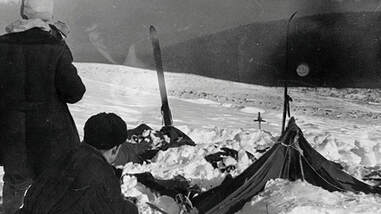 by M.P. Pellicer | Stranger Than Fiction Stories In 1959, a group of hikers were found horribly mutilated and killed in a part of Russia's Ural Mountains. Until this day who murdered them remains a mystery, and since then other persons have died or disappeared there. 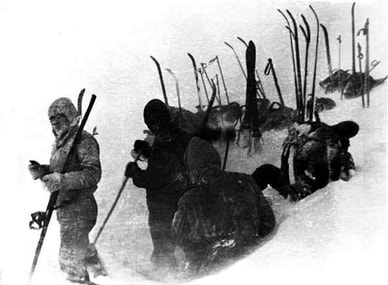 Dyatlov Pass hikers on their trek on the day before it's estimated they were killed c.1959 Dyatlov Pass hikers on their trek on the day before it's estimated they were killed c.1959 Dyatlov Pass is one of the most impassable regions of the Urals. Even the name of the region is shrouded in mystery and death. After the disappearance in 1959 of Igor Dyatlov and the hiking group he led, it has been known by this name. The group which made up the ill-fated journey in 1959, were students from the Ural Polytechnic Institute. Originally there were 10 students, but Yuri Yudin became sick and left the group. His illness saved his life. They were all experienced hikers and had planned a trek through the Urals to Mount Otorten, which translates in the local Mansi language as "don't go there". They failed to arrive on February 12, 1959, to the village of Vizhay, their destination point. This is 60 years to the day when Andreev disappeared. 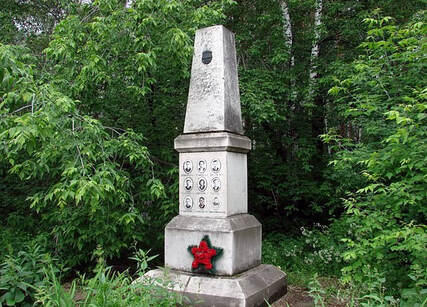 Dyatlov Pass Memorial Dyatlov Pass Memorial The group followed the Auspiya River into the mountains. In the group's diary there was no mention that they were in danger. A rescue mission found their tattered tent on February 26 on the slope of Mount Kholat Syakhl, which in Mansi translates to "Mountain of the Dead". The investigation turned up strange findings: the tent had been cut by a sharp object from the inside, and the group had left all their belongings inside the tent while fleeing the site. Five bodies were found down the hillside, some only wearing socks and underwear; the others were barefoot. Their bodies all bore signs of serious trauma. They had fractured skulls and broken ribs. Two months later the rest of the group were found dead in the woods. Inexplicably unusually high levels of radiation were detected in the camp. 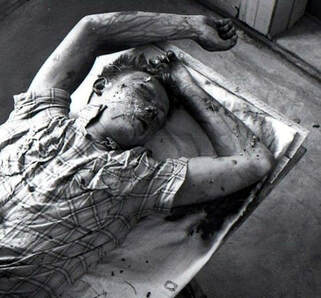 One of the deceased Dyatlov students c.1959 One of the deceased Dyatlov students c.1959 According to Mikhail Sharavin, one of the rescue party members, they saw several sets of deep footprints in the thick snow, but there was something wrong about those too. One set circled the tent and then ran away from the area. A few yards away they vanished as though the person had been lifted into the air. One of the students Yuri Doroshenko was found only wearing underwear; it was determined he died from hypothermia. Nearby they found branches from a tree had been broken off, but inexplicably they were stripped more than 16 feet up the trunk. Who or what broke them off? Doroshenko and another student Krivonischenko had matching burns on the palms of their hands. The remaining students who were found in the spring were located at the bottom of a ravine where water from a small stream flowed around their remains. They were buried under 9 feet of snow, and their bodies had been brutalized, and it was obvious that violence had been inflicted on them.  Frozen Dyatlov Pass student c.1959 Frozen Dyatlov Pass student c.1959 Three of them had died from their injuries and not the cold. One had his skull caved in, and two others had chest trauma and broken ribs. A young woman had her eyes and tongue missing, another had his eyes removed and a third had his neck twisted and his eyebrows were removed exposing his skull. What the discovery of the second group of bodies proved is that they did not all die at the same time. They were using clothes of the persons who died earlier. One had wrapped her foot in one of her companion's wool pants. Another hiker had died with this same woman's fur coat and hat on, indicating he had taken then after she died. It appeared each of the survivors were forced to use their dead companions' clothing in order to stay alive. Initially the investigators suspected the Mansi had attacked the group because they considered them trespassers, however by the end it was concluded only the hikers had been on the mountain. 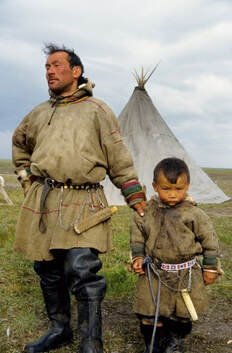 Mansi man and boy Mansi man and boy The investigation in 1959, fresh after the incident could not establish the cause of death for any of the members, and the final report concluded they had been killed by an "unknown compelling force". In the ensuing years, the theories for the attack range from an avalanche, secret military tests, an unknown creature and extraterrestrials. In 2018, Aleksandr Andreev from Ekaterinburg was reported lost in the pass, after being overdue for three weeks. He was on a solo journey into a remote section of Russia. Local volunteers organized a rescue mission, but nothing was found, only a message dated from February 17, which read: "everything was going well." Due to the harsh conditions in the Ural it was feared he might be deceased. Since he had not registered with the local search and rescue offices with his route, searching a vast area was more difficult and time consuming than it normally would have been. What also contributed to the difficulty was that authorities became aware he was missing, only after his relatives reported he had not checked in. In 2019, Russia's prosecutor general's office found that of the 75 existing theories for the death of the hikers none were conclusive, however they attested the government had nothing to do with the incident. Only three scenarios were considered, all which related to extreme weather. Theories that an avalanche could have been what killed the group have been found to be possible, but not probable. The theory of a "slab avalanche" was proposed, but does not explain the injuries to the hikers' bodies, and a hurricane seemed to be just as far-fetched.  The original student hikers c.1959 The original student hikers c.1959 In January 2016, hikers found the body of a 47-year-old man, which was later identified as a local "hermit". He had lived on his own for a long time near the Dyatlov Pass. The following month, rescuers found the body of a man who tried to get on his own to a Buddhist monastery. His cause of death was hypothermia. A member of a tourist group "died suddenly" in September, 2017. The 58-year-old hiker died from cardiac arrest. In 2021, a group of eight hikers, made of five tourists and three guides were missing. They were unregistered, and one of their family members reported them overdue when they couldn't communicate with one of the party. It turned out bad weather had interfered, but their story ended much better then the group in 1959.  Dubinina, Krivonischenko, Thibeaux-Brignolles, and Slobodin having a good time, taken by Krivonischenko’s camera c.1959 Dubinina, Krivonischenko, Thibeaux-Brignolles, and Slobodin having a good time, taken by Krivonischenko’s camera c.1959 Once one puts aside the theories of an avalanche or hypothermia as the culprits, other less mundane explanations come into play. One of them is the menk, a big-foot or yeti type being, which is part of the Mansi folklore and is known as a forest spirit. This could explain the degree of injuries that was inflicted on the group. Could there have been secret testing of some type of weapon close to where the group camped? Perhaps what they saw or heard drove them outside of their tent, allowing hypothermia to gradually kill them all as they succumbed to the weather. Another group camping about 30 miles away saw orange orbs in the sky around Kholat Syakhl, which coincided to the time period it's estimated the Dyatlov team died. Were these explosions or perhaps even UFOs? In 1990, Lev Ivanov the chief investigator of the Dyatlov Pass Incident was interviewed by a newspaper where he alluded that the "bright flying sphere had a direct connection the group's death." His communist overlords quickly shut him down. Tatyana Perminova, Igor Dyatlov's sister told the BBC the family was told: "You will never know the truth, so stop asking questions." It seems the answers to the mystery of what happened that day in Dyatlov Pass was something the students took to their graves at Mikhajlov Cemetery at Yekaterinburg.
0 Comments
Your comment will be posted after it is approved.
Leave a Reply. |
Stranger Than Fiction StoriesM.P. PellicerAuthor, Narrator and Producer Archives
July 2024
Categories
All
|
Stories of the Supernatural
- Stories of the Supernatural
- Miami Ghost Chronicles
- M.P. Pellicer | Author
- Stranger Than Fiction Stories
- Eerie News
- Supernatural Storytime
-
Astrology Today
- Tarot
- Horoscope
- Zodiac
-
Haunted Places
- Animal Hauntings
- Belleview Biltmore Hotel
- Bobby Mackey's Honky Tonk
- Brookdale Lodge
- Chacachacare Island
- Coral Castle
- Drayton Hall Plantation
- Jonathan Dickinson State Park
- Kreischer Mansion
- Miami Biltmore Hotel
- Miami Forgotten Properties
- Myrtles Plantation
- Pinewood Cemetery
- Rolling Hills Asylum
- St. Ann's Retreat
- Stranahan Cromartie House
- The Devil Tree
- Trans-Allegheny Lunatic Asylum
- West Virginia Penitentiary
- Paranormal Podcasts
"When misguided public opinion honors what is despicable and despises what is honorable, punishes virtue and rewards vice, encourages what is harmful and discourages what is useful, applauds falsehood and smothers truth under indifference or insult, a nation turns its back on progress and can be restored only by the terrible lessons of catastrophe."
- Frederic Bastiat
- Frederic Bastiat

Copyright © 2009-2024 Eleventh Hour LLC. All Rights Reserved ®
DISCLAIMER
DISCLAIMER
 RSS Feed
RSS Feed
















